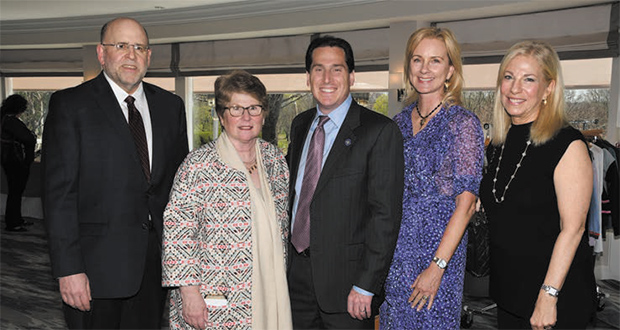
by North Shore Child & Family Guidance Center | May 30, 2018 | In The Media
 In a report issued by Nassau County’s Department of Health—Community Health Assessment and Community Health Improvement Plan (2016-18)—there is no mention of maternal mortality or information on social and environmental risk factors for women and infants of color. Consequently, no initiatives to address maternal and infant mortality disparities are recommended, yet overall Nassau County health data indicates that it ranks at the top of all counties in New York State.
In a report issued by Nassau County’s Department of Health—Community Health Assessment and Community Health Improvement Plan (2016-18)—there is no mention of maternal mortality or information on social and environmental risk factors for women and infants of color. Consequently, no initiatives to address maternal and infant mortality disparities are recommended, yet overall Nassau County health data indicates that it ranks at the top of all counties in New York State.
To address this “invisible injustice,” maternal and child health advocates convened at Hofstra University on March 23 for a Birth Equity Breakfast organized by the Nassau County Perinatal Services Network.
Birth equity refers to the assurance that all human beings have the best possible births, buttressed by careful attention to racial and social disparities.
Keynoter Dr. Martine Hackett, assistant professor at Hofstra University’s School of Health Professions and Human Services, presented data from the state Department of Health that showed the disparate outcomes for black mothers and babies as compared with their white counterparts.
Infant mortality refers to the death of children before their first birthdays, which is a key indicator of the overall health of a population. According to the United Nations International Children’s Fund (UNICEF), Japan is the number one ranked country for newborn survival, while the United States ranks only 22nd in the world.
Among the eye-opening data that Hackett cited are the differences between the infant mortality rates in contiguous communities in Nassau County. For example, in Roosevelt there were 11.1 infant deaths per 1,000 births from 2012-14, while neighboring Merrick had zero deaths. Overall, in Nassau County the black infant mortality rate is more than four times that of the White infant mortality rate and even higher than in New York City.
Dr. Joia Creer-Perry, president of the National Birth Equity Collaborative, spoke about the perception of black mothers and the barriers to receiving holistic care by the health care system. If a woman is living under great stress she will have trouble carrying her baby to term. Premature birth to underweight babies is a leading cause of infant mortality.
Social justice activist and attorney Fred Brewington condemned the institutional racism prevalent in healthcare that has resulted in infant mortality figures today that are no different than they were almost a century ago.
Just weeks after the Birth Equity Breakfast, Tasha Portley, a nurse living in Tyler, TX, spoke at a similar forum halfway across the U.S. In a report published in the April 16 edition of the Tyler Morning Telegraph, Portley stated that “Pregnant black women often experience casually degrading remarks from white people when they seek maternal health care.”
Portley shared the story of a black woman who had some difficulty acquiring a breast pump from a local social services agency and, in the process, was the target of demeaning remarks by an employee. Portley went on to say, “We are dying because we are black and we are living in a country where there is inherent racism. It is systemic. It is the thread; it is the fiber of everything that exists.”
Hackett highlighted what needs to happen in order to turn the corner on disparities in Nassau County. Among her recommendations were to inform women after childbirth of warning signs for hemorrhage, embolism or infection, especially when there are preexisting conditions; to enhance service integration for women and infants; and to treat women of color with dignity, respect and culturally relevant care.
Bringing birth inequities to light is an important step forward. When this issue is not identified in Nassau County health data, people don’t know about it and it cannot be addressed. The breakfast concluded with the unveiling of the Birth Justice Warriors, an initiative envisioned by Hackett, to train birth advocates with the hope of ameliorating the birth inequities in Nassau County.
Andrew Malekoff is the Executive Director of North Shore Child & Family Guidance Center, which provides comprehensive mental health services for children from birth through 24 and their families, including support for pregnant and parenting teens and their babies. To find out more, visit www.northshorechildguidance.org.

by North Shore Child & Family Guidance Center | May 30, 2018 | Blog
A few years ago, in an effort to better understand where sex and social media intersect with respect to attitudes and behavior, The National Campaign to Prevent Teen and Unplanned Pregnancy conducted a survey of teens and young adults. The study measured the proportion of them who are posting sexually suggestive text and images. There were a total of 1,280 respondents— 653 teens (ages 13-19) and 627 young adults (ages 20-26).
The survey found that a significant number of the 13-19 year olds have electronically sent, or posted online, nude or semi-nude pictures or video of themselves. Sexually suggestive messages via text, email or IM (instant message) were even more prevalent according to the survey. Seventy-five-percent of the teen respondents and 71% of young adults said sending sexually suggestive content “can have serious negative consequences,” yet they continue this behavior despite substantial personal safety and legal risks.
Parents, caregivers and other relevant people in kids’ lives need to be attuned to this behavior and be prepared to address it.
Despite the influence of peers, which is not all negative, this is only one part of a four-part community that includes family, larger community and media influences, all of which have demonstrable effects on adolescents’ sexual attitudes and behavior and all of which interact in a complex way. For example, beyond the peer group are information and images transmitted by the media that may typify values that are detrimental to young people’s self-image and health.
In families in which sexuality is not a taboo subject and related discussions occur quite naturally throughout childhood, pathways are forged for ongoing dialogue about all aspects of sexuality. If parental influence is strong enough—that is, if their relationships with their children are warm and close and their parenting style is authoritative—it can be a powerful protector against negative peer influence.
The American Academy of Pediatrics offers some good tips for talking to you kids about texting (go to www.aap.org and search for “sexting”):
- Talk to your kids, even if the issue hasn’t directly impacted your community. “Have you heard of sexting?” “Tell me what you think it is.” For the initial part of the conversation, it is important to first learn what your child’s understanding is of the issue and then add to it an age-appropriate explanation (see next bullet).
- Use examples suited to your child’s age. For younger children with cell phones who do not yet know about sex, alert them that text messages should never contain pictures of people—kids, teens or adults—without their clothes on, kissing or touching each other in ways that they’ve never seen before. For older children, use the term “sexting” and give more specifics about sex acts they may know about. For teens, be very specific that “sexting” often involves pictures of a sexual nature and is considered pornography.
- Make sure kids of all ages understand that sexting is serious and considered a crime in many jurisdictions. If they “sext,” there will be serious consequences, quite possibly involving the police, suspension from school, and notes on the texter’s permanent record that could hurt their chances of getting into college or getting a job.
- Experts have noted that peer pressure can play a major role in the sending of texts, with parties being a major contributing factor. Collecting cell phones at gatherings of tweens and teens is one way to reduce this temptation.
- Monitor headlines and the news for stories about sexting that illustrate the very real consequences for both senders and receivers of these images. “Have you seen this story?” “What did you think about it?” “What would you do if you were this child?” Rehearse ways they can respond if asked to participate in inappropriate texting.
- Encourage school and town assemblies to educate parents, teachers and students.
An important and related problem is that with social networking there is no respite. Social media has a 24-7 quality that leaves many teens feeling that there is nowhere to turn and no escape.
Social media has opened the door to new avenues of sexual expression and new challenges for families, health educators and human services professionals. Don’t miss this opportunity to educate your youngster about its dangers.
Note: This story originally appeared in a column in Anton Media. It was written by North Shore Child & Family Guidance Center Executive Director Andrew Malekoff.
![2018 Spring Luncheon, From LIBN’s On Our Island, May 18-24, 2018]()
by North Shore Child & Family Guidance Center | May 23, 2018 | In The Media

From left): Andrew Malekoff, Nancy Lane, Todd Kaminsky, Jo-Ellen Hazan and Andrea Leeds participated in North Shore Child & Family Guidance Center’s Spring Luncheon.

by North Shore Child & Family Guidance Center | May 23, 2018 | Blog
Last weekend’s royal wedding went off without a hitch. It was a beautiful day filled with many touching moments, and it will also be known as the most inclusive and diverse wedding in the history of the royal family.
In the weeks and months to come, Prince Harry and Princess Meghan will likely be defining the role that they plan to take in terms of philanthropic efforts. But it’s clear that Princess Meghan will be an active proponent of causes that she cares for. The BBC reported that, after announcing the engagement, she said, “What’s been really exciting, as we talk about this as the transition out of my career… is that the causes that have been very important to me, I can focus even more energy on.”
Among her current activities, she has already been a global ambassador for World Vision, which works to help children, families, and their communities reach their full potential by tackling the causes of poverty and injustice.
But Meghan Markle’s advocacy work came long before she was a princess. At just 11 years old, after seeing a sexist TV ad, she wrote letters to Hillary Clinton, Linda Ellerbee, Gloria Allred, and the company responsible for the ad. According to Harper’s Bazaar, Markle received replies from all three women, and the soap company changed the wording in the commercial.
For his part, Prince Harry has spoken passionately on many issues, with one of them being mental health. Along with his brother and sister-in-law, Prince Harry created the Heads Together organization, which advocates for open discussion and better services for people in need of mental health care. (click here for a video of Prince William, Princess Kate and Prince Harry discussing the issue).
The Duke and Duchess of Cambridge and Prince Harry said:
“Since we launched Heads Together last May, we have seen time and time again that shattering stigma on mental health starts with simple conversations. When you realise that mental health problems affect your friends, neighbours, children and spouses, the walls of judgement and prejudice around these issues begin to fall. And we all know that you cannot resolve a mental health issue by staying silent.”
In a personal story in Britain’s Metro News on May 19, the day of the wedding, a parent wrote a touching article about what it’s like to have a child in need of mental health care. You can read the entire piece here, but below are some excerpts.
“We were naive at the beginning. We assumed that getting help for our son’s mental health issues would be straight forward and trusted the system. After all, if it was a broken leg we would have taken him to A&E and the wait for help would take hours rather than months and months. That sounds flippant, of course they are completely different, but the months rolled on and eventually I gave up and called the pediatrician’s office. ‘You haven’t dropped off the radar’ we were told. It definitely felt like we had. At seven, my son developed a neurological condition which came with comorbids – for him, it included OCD, anxiety, and depression.
In an ideal world, waiting lists will be halved at least. Every school would have a mental health practitioner, and appointments would take place on site meaning no more half days off school for appointments. I think having care available in school would make children feel less ‘different’ as having to take half days for hospital visits means missing out on school work and inevitably leads to being questioned by schoolmates about where they’ve been.
Classes looking at mental health, well-being and how to manage your own mental health would be introduced from a young age. These children need to know how to cope but also that they’re no different, many people have issues with their mental health, that it’s not shameful or embarrassing. They are normal.”
READ THE FULL ARTICLE HERE.
Want to get involved in advocating against stigma, or need help? Follow us on Facebook at www.facebook.com/NSCFGC/, or call (516) 626-1971 for an appointment.
Sources:
https://www.harpersbazaar.com/celebrity/latest/a13945782/meghan-markle-charity-work-philanthropy/
https://metro.co.uk/2018/05/19/what-its-like-to-be-a-parent-of-a-child-with-mental-health-issues-7550542/
https://www.headstogether.org.uk/
![2018 Spring Luncheon, From LIBN’s On Our Island, May 18-24, 2018]()
by North Shore Child & Family Guidance Center | May 22, 2018 | In The Media
On Tuesday, May 15, the Welcoming Club of Garden City hosted their Spring Soirée at the Garden City Hotel, with all proceeds going to benefit North Shore Child & Family Guidance Center, the premiere not-for-profit children’s mental health agency on Long Island.

The event featured fabulous boutique shopping, getting-to-know-you games, a Garden City trivia contest, great raffle prizes and a delicious buffet.
“Tuesday was a fun and fabulous night that allowed the ladies of the Welcoming Club of Garden City to come together with old friends and mix and mingle to meet new ones in a chic and festive atmosphere,” says Meg Dockery-Cremins, president of the Welcoming Club. “The Spring Soirée was the culmination of a year’s worth of family, couples and ladies events to benefit North Shore Child & Family Guidance Center. The wonderful vendors along with our generous community sponsors provided fabulous prizes which will allow us to make a generous donation to The Guidance Center, which we view as a critically important organization in the community.”
“We are so grateful to the members of the Welcoming Club of Garden City for making us the beneficiary of their events for September 2017 through June 2018,” says Lauren McGowan, Director of Development for North Shore Child & Family Guidance Center. “The funds that they raise will go directly to our core mission of helping Long Island children and their families who are in need of mental health or substance use care. We could not do our work without generous donations from community-minded organizations like the Welcoming Club.”

 In a report issued by Nassau County’s Department of Health—Community Health Assessment and Community Health Improvement Plan (2016-18)—there is no mention of maternal mortality or information on social and environmental risk factors for women and infants of color. Consequently, no initiatives to address maternal and infant mortality disparities are recommended, yet overall Nassau County health data indicates that it ranks at the top of all counties in New York State.
In a report issued by Nassau County’s Department of Health—Community Health Assessment and Community Health Improvement Plan (2016-18)—there is no mention of maternal mortality or information on social and environmental risk factors for women and infants of color. Consequently, no initiatives to address maternal and infant mortality disparities are recommended, yet overall Nassau County health data indicates that it ranks at the top of all counties in New York State.



